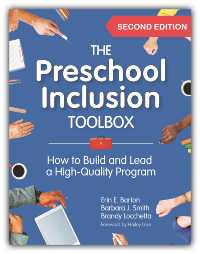Preschool Inclusion: 11 Essentials for Team Planning
July 1, 2025
 Preschool inclusion benefits all children, with and without disabilities. It takes a highly focused and effective team to implement sustained, high-quality inclusion, and the guidelines in today’s post can help your school staff collaborate and communicate to get the work done. Adapted from The Preschool Inclusion Toolbox, Second Edition, this quick guide to planning is a great starting point for ensuring that your preschool inclusion team stays on the right track.
Preschool inclusion benefits all children, with and without disabilities. It takes a highly focused and effective team to implement sustained, high-quality inclusion, and the guidelines in today’s post can help your school staff collaborate and communicate to get the work done. Adapted from The Preschool Inclusion Toolbox, Second Edition, this quick guide to planning is a great starting point for ensuring that your preschool inclusion team stays on the right track.
Build your team
The first step is to identify others who want to create more quality preschool inclusion opportunities.
- Optimal Size: Limit the team to no more than 15 members to ensure effective collaboration. Larger groups can provide input through alternative methods such as focus groups, work groups, and surveys.
- Key Stakeholders: Ensure representation from crucial areas, including administration, teachers, parents, related services personnel, and community members. This diversity ensures all perspectives are considered and ensures community engagement for capacity building.
Clarify commitments
- Shared Vision: All members must be committed to the goal of high-quality preschool inclusion.
- Long-Term Engagement: Members should be prepared for a multiyear process, understanding that meaningful change takes time.
- Positive Collaboration: Team members must be committed to working together positively and collaboratively.
- Ground Rules: Develop and uphold meeting ground rules. Review regularly and change and adapt as needed.
- Format: Make a decision about meeting online or virtually, and have specific ground rules for each format.
Insist on consistency
No substitutes! To build trust and maintain continuity, team members should attend all meetings in person and not send representatives.
Build consensus
Strive to make decisions by consensus whenever possible. If a member is absent, they agree to support decisions made in their absence.
Establish critical meeting roles
- Timekeeper: A volunteer from the team ensures the agenda is followed and adjusts if necessary.
- Notetaker: A volunteer records meeting summaries unless administrative support is provided. If using a computer application to record meeting notes, this person will review and distribute notes after each meeting.
- Facilitator: A volunteer leads the meeting, ensuring productive and inclusive discussions.
Set your schedule
- Regular Meetings: Schedule meetings at least monthly for a minimum of 1 hour. Set the time and date at least 6 months in advance.
- Parent Participation: Provide reimbursement for parent expenses and offer refreshments to ensure inclusive participation if in person.
- Punctuality: Start and end meetings on time to respect everyone’s schedules.
Utilize facilitation
- Objective Facilitation: Effective meetings require a facilitator focused on ensuring all voices are heard. This role should rotate among members. When possible, we recommend the facilitator remain neutral and not participate in making or voting on decisions.
- Facilitation Practices: Utilize established facilitation strategies to ensure productive discussions and shared decision making (detailed decision-making activities can be included as per below).
Prepare meeting materials
- Agendas: Prepare written agendas with input from the team and share them in advance.
- Action Plans: Use updated action plans to guide each meeting’s agenda.
Set ground rules for respectful communication
You might send out ground rules like the following to ensure a productive, respectful, and inclusive meeting environment:
- One Mic Rule: Only one person speaks at a time. Everyone else listens.
- Turn Taking: Each person has the opportunity to speak before anyone speaks twice.
- No Distractions: No side conversations, and phones should be on silent mode.
- Respectful Disagreement: Disagree with ideas, not people.
- Confidentiality Agreement: What’s said in the meeting stays in the meeting.
- Parking Lot: Use a “parking lot” for off-topic items to be discussed later.
- Timekeeper Alerts: The timekeeper will alert the group when there are 5 minutes remaining for a topic.
- Check-In/Check-Out: Begin with a brief check-in and end with a check-out to gauge how members are feeling.
For a virtual meeting, you might add:
- Test technology beforehand and log in a few minutes early to address any technical issues
- Mute when not speaking
- Use the chat function for questions or comments
- Avoid multitasking; focus on the meeting and participate fully
- Minimize background noise
- Use a neutral virtual background if your surroundings are distracting
Evaluate team meetings
Regularly evaluate meetings to continuously improve their effectiveness.
Celebrate success
Acknowledge achievements! Regularly celebrate both small and significant accomplishments to maintain motivation and morale.
By following these guidelines and leveraging current research on teaming, your preschool inclusion team can create a structured, effective, and inclusive environment. This foundation will support your team’s goal of enhancing quality preschool inclusion opportunities, ensuring that all children receive the best possible start in their educational journey.
For a complete, in-depth guide to implementing and sustaining full-scale preschool inclusion, check out the book behind this post!




Write a Comment
Your email address will not be published. Required fields are marked *
Post a Comment